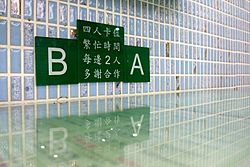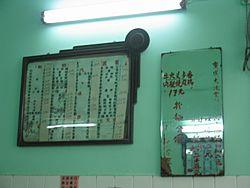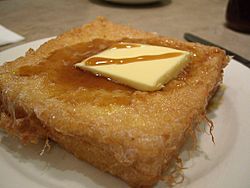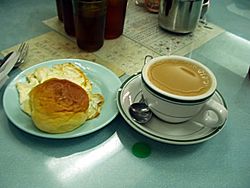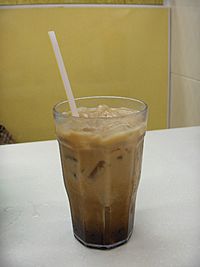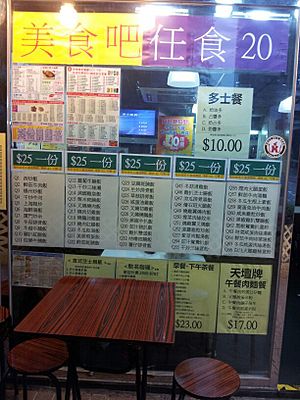Cha chaan teng facts for kids
Quick facts for kids Cha chaan teng |
|||||||||||||||||
|---|---|---|---|---|---|---|---|---|---|---|---|---|---|---|---|---|---|
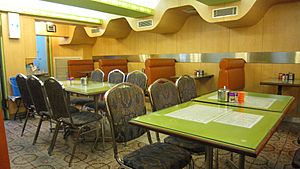 |
|||||||||||||||||
| Traditional Chinese | 茶餐廳 | ||||||||||||||||
| Simplified Chinese | 茶餐厅 | ||||||||||||||||
| Jyutping | caa4 caan1 teng1 | ||||||||||||||||
| Literal meaning | "tea restaurant" | ||||||||||||||||
|
|||||||||||||||||
A Cha chaan teng (which means "tea restaurant" in Chinese) is a special kind of restaurant that started in Hong Kong. People often call them a Hong Kong-style cafe or diner in English. You can find many of these restaurants in Hong Kong, Macau, and parts of Guangdong.
Because many people moved from Hong Kong in the 1980s, cha chaan tengs are now also in big Chinese communities in countries like Australia, Canada, the United Kingdom, and the United States. They are like a casual cafe or an American diner. Cha chaan tengs are famous for their interesting and cheap menus. These menus include dishes from Hong Kong cuisine and Hong Kong-style Western cuisine. They are also known for their relaxed atmosphere and drinks like coffee and tea.
Contents
The Story of Cha Chaan Tengs
How Hong Kong's Tea Restaurants Began
Before the 1950s, Western food in Hong Kong was mostly found in fancy restaurants. Only rich people could afford to eat there. For example, in the 1920s, a Western meal could cost $10. But most working people only earned $15 to $50 a month.
After Second World War, British culture influenced Hong Kong. People started adding milk to their tea and eating cakes. Some Hongkongers opened cha chaan tengs for local people. These places offered different kinds of Canto-Western food and drinks at very low prices. People called this "cheap Western food" or "soy sauce Western food."
Growing Popularity in the 1950s and 60s
In the 1950s and 60s, more cha chaan tengs opened. This was because people had more money. They could now afford this "Western food." Older "soy sauce Western restaurants" and bing sutt (which means "ice rooms") changed into cha chaan tengs. This helped meet the high demand for affordable and quick Hong Kong-style Western food.
Cha Chaan Tengs Today
In recent years, cha chaan tengs have changed with Hong Kong's economy. During the 1997 Asian Financial Crisis, they became even more popular. They still offered the cheapest food for everyone.
Before 2007, most cha chaan tengs allowed people to smoke. Some waiters even smoked while working. But since January 1, 2007, a Hong Kong law stopped smoking inside restaurants.
In 2007, some people suggested that cha chaan tengs should be added to the UNESCO Intangible Cultural Heritage Lists. This was because they are so important to Hong Kong culture. A survey showed that seven out of ten people thought they deserved this honor. However, cha chaan tengs were not added to UNESCO's lists.
In June 2014, some famous cha chaan teng items were added to Hong Kong's own list of important cultural heritage. These included milk tea, yuenyeung, pineapple bun, and egg tart.
What Does "Cha Chaan Teng" Mean?
The name "tea restaurant" helps tell these places apart from Western restaurants. Western restaurants usually give water to customers. Cha chaan tengs give customers a light tea called "clear tea" (清茶) as soon as they sit down. Some people even use this hot tea to wash their utensils. This is a common custom in Hong Kong.
The "tea" in the name means inexpensive black tea. This is different from the traditional Chinese tea served in dim sum restaurants. The "tea" can also mean popular tea drinks. These include Hong Kong-style milk tea and iced lemon tea. Older Hongkongers call eating at these restaurants yum sai cha. This means "drinking Western tea." It's different from yum cha, which is about Chinese tea and dim sum.
Some cha chaan tengs use the word "café" in their names. This is especially true in English-speaking countries. There, they are known as "Hong Kong–style cafes." They are famous for serving yuenyeung and Hong Kong–style coffee.
The Culture of Cha Chaan Tengs
Quick Service and Busy Life
Tea restaurants are known for being very fast. Customers usually stay for only 10 to 20 minutes. Dishes often arrive in about five minutes. Waiters take orders with one hand and serve food with the other. This shows Hong Kong's busy way of life. During busy times, long lines form outside many restaurants.
Long Working Hours for Staff
The people who work in a cha chaan teng often work very long hours. Sometimes they even work night shifts.
Changes and Trends
Because land is limited and rent is expensive, chain restaurants are slowly replacing cha chaan tengs. As chain restaurants become more common, the unique cha chaan teng culture in Hong Kong is changing. However, they are becoming more popular in other countries. Many are opening in Chinese communities as a casual choice instead of more traditional Chinese restaurants.
Secret Codes and Phrases
To make ordering faster, waiters use special short forms when writing orders. Customers also use their own special phrases.
- The character 反 (faan) means "opposite." It is used for 白飯 (baak faan), which means "steam rice."
- "0T" means lemon tea. The "0" sounds like the first part of "lemon" in Cantonese. "T" is for "Tea."
Customers use phrases like:
- 走冰 (zau bing) or 走雪 (zau syut): This means "no ice" in cold drinks.
- 飛砂走奶 (fei saa zau naai): This means "no sugar or milk" in coffee or tea. "Sand" means sugar.
- 茶走 (caa zau): This means milk tea without sugar. Instead, condensed milk is used for sweetness.
- 加底 (gaa dai): This means "add extra rice or noodles" to a dish. It usually costs more.
- 炒底 (caau dai): This means "stir-fry the rice or noodles" in a dish.
What's on the Menu?
A cha chaan teng serves many different foods. You can find everything from steak to wonton noodles, curry, and sandwiches like Hong Kong-style French toast. They offer both fast food and dishes you order separately. A large cha chaan teng often has three cooking areas:
- A "water bar" (水吧) makes drinks, toast, sandwiches, and instant noodles.
- A "noodle stall" makes Chiuchow-style noodles, including wonton noodles.
- A main kitchen makes rice plates and other bigger dishes.
Popular Food and Drinks
Drinks to Try
Cha chaan tengs are famous for inventing drinks like yuenyeung (a mix of coffee and tea), iced tea with lemon (凍檸茶), and Coca-Cola with lemon (檸樂).
- Coffee: Often served with condensed milk, especially outside Hong Kong.
- Black coffee: Called jaai fea (plain coffee) or "fei sha jaau naai" (coffee without sugar or milk).
- Hong Kong-style milk tea: A very popular drink. It's judged by its smell, smoothness, and strength. The tea is soaked for hours to get the best flavor. If you want condensed milk instead of regular milk, say "caa zau."
- Sweet soy milk (豆漿): Soy milk with cane sugar, served hot or cold.
- Yuenyeung: A mix of coffee and tea, created in Hong Kong. Some believe coffee is "hot" and tea is "cold," so mixing them makes a balanced drink.
- Black and White Yuenyeung: A mix of Ovaltine and Horlicks, also from Hong Kong.
- Horlicks
- Ovaltine
- Lemon Tea
- Lemonade: Usually served without sugar.
- Lemon with Ribena
- Lemon with Honey: Sometimes "Watercress Honey" is used instead of real honey to save money.
- Salted lemon with 7-Up (鹹檸七): 7-Up with lemon that has been soaked in salt. It's good for a sore throat.
- Black cow (黑牛): Coca-Cola with vanilla ice cream.
- Snow White (白雪公主): Sprite or 7-Up with vanilla ice cream.
- Cream Soda with Milk (忌廉溝鮮奶): A popular drink in the 1970s.
- Boiled water with egg (滾水蛋): A raw egg added to boiled water. This was popular in the 1960s when people couldn't afford much meat. It's usually drunk with white sugar.
- Red bean ice: A drink with red beans, evaporated milk, and ice.
- Soft drinks: Coca-Cola, 7-up, Fanta, and Cream Soda are common choices.
Sometimes, adding ice to a drink costs a little extra. Some people just ask for a glass of ice.
Snacks to Enjoy
- Toast: This includes toast with condensed milk and butter or peanut butter. You can also get toast with jam and butter, or just butter. Hong Kong-style French toast is also very popular.
- Sandwich: Cha chaan teng sandwiches often have egg, ham, corned beef, or a mix of these. Club sandwiches are also common. They usually use only white bread. You can ask for the crust to be removed or for the bread to be toasted.
- Egg tart
- Hong Kong-style buns: These include pineapple buns (sometimes with butter inside), cocktail buns, Satay beef buns, and barbecued pork buns (cha siu bao).
- Spring rolls
Main Dishes
- Fried dishes: Many kinds of fried rice and noodles. Also, Hong Kong-style spaghetti bolognese and fried instant noodles.
- Soup dishes: Instant or udon noodles in soup. Macaroni in soup. Soup noodles with fish balls, wontons, meat balls, and other seafood.
- Other dishes: Char siu (barbecued pork) is sometimes available. Also, Congee (rice porridge) and yau ja gwei (fried dough sticks).
Special Set Meals
A unique thing about cha chaan tengs is their set meals. There are different sets for breakfast, lunch, afternoon tea, and dinner. Lunch and dinner sets usually come with a soup and a drink. Cold drinks often cost a little extra (about HK$2-3). Sometimes, toasting the bread costs an extra HK$5.
Other types of sets include:
- "Nutritious set" (營養餐): Comes with milk and other healthy foods.
- "Constant set" (常餐): Available all day. It usually has a main dish, omelette, wheat food (like spiced pork or luncheon meat), white bread with butter, and a drink.
- "Fast set" (快餐): Served quickly. Usually rice with sausages, ham, or fried eggs with gravy.
- "Special set" (特餐): The chef's or boss's special recommendation.
Tables and Seating
Tables in cha chaan tengs are usually square for four people or round for six to eight people. Each table has a glass top with menus placed underneath. During busy times like lunch or dinner, customers might be asked to "daap toi" (搭枱). This means they share a table with other customers. This helps save space and lets more people get a seat quickly.
Inside the Restaurant and Utensils
Many plastic items on the tables, like toothpick holders and menu stands, are given by drink companies for advertising. Brands like Ovaltine, Horlicks, and Ribena often provide these. To save money, cha chaan tengs rarely have their own brand name on utensils. So, you might see the same forks and spoons in many different cha chaan tengs. These items can be bought in supermarkets or stores that sell restaurant supplies.
The walls and floors in cha chaan tengs are often tiled. This makes them easier to clean, especially in Hong Kong's humid summer weather. In other countries, these restaurants often have Chinese newspapers and TVs on the wall showing Hong Kong news.
Different Kinds of Tea Restaurants
Other local restaurants in Hong Kong are similar to cha chaan tengs. These include chaan sutt (餐室; "meal chamber"), bing sutt (冰室; "ice chamber"), and bing teng (冰廳; "ice dining room"). These places used to offer a smaller and lighter menu than cha chaan tengs.
In the past, these eateries only sold "ice" (like iced drinks), sandwiches, and pasta. They did not serve rice dishes. However, today, some restaurants with these names offer all kinds of rice plates and even wonton noodles. The original chaan sutts, bing sutts, and bing tengs, which were like the first cha chaan tengs, are now hard to find in Hong Kong.
In June 2009, a Hong Kong design store called G.O.D. worked with Starbucks. They created a store on Duddell Street with a "Bing Sutt Corner." This idea mixed the old Hong Kong teahouse style with a modern coffee shop look.
Buffet Style Cha Chaan Tengs
Some cha chaan tengs have started offering a buffet style of service. Fei Du Du Cha Chaan Teng in Tsuen Wan was the first to try this in 2013. The owner, Stephen Cheng, wanted a new way to run his business because of high rent and rising prices. This idea was successful, and other restaurants also started offering buffets.
Customers generally liked the buffet style because prices became lower. One customer said the meal was almost 70% cheaper than food in nearby areas.
Images for kids
See also
 In Spanish: Cha chaan teng para niños
In Spanish: Cha chaan teng para niños


